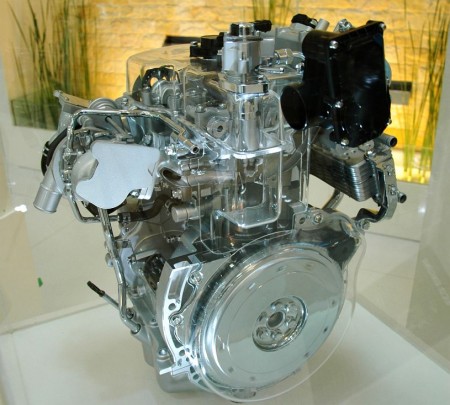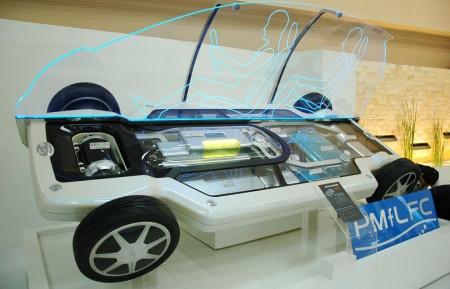Perodua is certainly ramping things up, by the looks of it – besides the Bezza concept car, the company presented a glimpse into its technology plans for the coming future at KLIMS, with an engine development road map working towards the eventual introduction of a Precious Metal-free Liquid-feed Fuel Cell-based vehicle.
The company says that for the immediate term things will be based along internal combustion engine lines, which of course it will be working on with its technical partner Daihatsu.
“As a compact car manufacturer, we choose this path as the internal combustion engine still has a lot of life in it and we believe that the reduction of our carbon emission by producing more efficient engines that will be more cost effective and will leave a smaller carbon footprint to the environment,” Perodua’s managing director Datuk Aminar Rashid Salleh said.
“In order to provide compact cars that are affordable by the next generation, we are pursuing the ultimate of conventional technologies rather than hybrid technologies that tend to be too expensive for the average motorists,” he added.
With the first stage being mass-produced engines with DVVT, the second stage is where it gets interesting – the next generation eco-engine that it is planning will be a 660cc inline two-cylinder turbocharged engine with direct fuel injection, offering 63 hp at 4,500 rpm and 100 Nm of torque at 1,500 to 4,000 rpm, and P2 says that this one will offer a 30% improvement in fuel efficiency over a current similar displacement block. The engine is something that Daihatsu has announced before, so I suppose this confirms that it will eventually trickle down to Perodua usage.
It will also feature ultra high-volume exhaust gas recirculation as well as a new active ignition system, the latter having an ignition plug with high-frequency, plasma-assisted voltage to strengthen the first electric discharge. The company says that the new block will offer three major advantages – improved combustion, reduced power loss and a flat, high torque curve.
Further away in the distance, the final destination of this green engine roadmap is the Precious Metal-free Liquid-feed Fuel Cell, which the company says is the best alternative for the internal combustion engine as it does not use precious metals and produces zero carbon emissions.
Meanwhile, on the drivetrain front, the company also announced that production of its electronic automatic transmission (E-AT) system locally is targeted to start in the next couple of years. “While the technology is not something new, we will be the first in Malaysia to produce the E-AT system,” Aminar said. The E-AT transmission is currently incorporated in the Myvi and Alza. It’s basically the 4-speed gearbox.
Looking to sell your car? Sell it with Carro.





















AI-generated Summary ✨
Comments generally express skepticism or amusement about Perodua's claim to develop a new 2-cylinder direct injection turbo engine, with many believing it is rebadged technology from Daihatsu and Toyota rather than an entirely new development. Online links and references suggest that the engine is likely a Daihatsu design, leading to accusations of false claims about innovation. Some commenters highlight that Perodua's strength lies in assembly and rebadging, not in R&D, and suggest that their advancements are limited to marketing terms. Others jokingly or seriously recommend more advanced options like electric vehicles or hybrid systems. Overall, the sentiment is largely doubtful, with many referring to Perodua as a rebadger rather than a technology innovator, while a few support the move as a step forward.